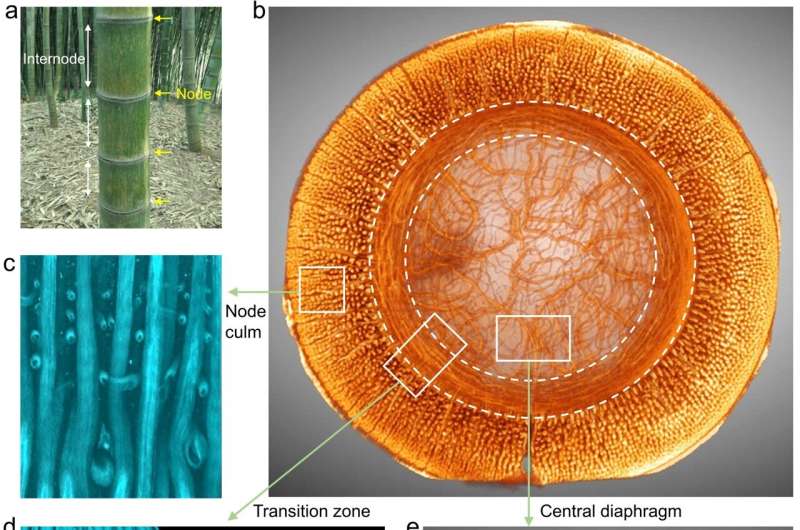Elegant hierarchical fiber organization within the bamboo node

In a study recently published in National Science Review, researchers used multiscale imaging techniques (including optical microscope, X-ray microscope (micro-CT), scanning electron microscope, and atomic force microscope, etc.) to scientifically characterize the fiber-based microstructure of the short bamboo node. Experiment results revealed that the bamboo node can be seen as one spatially heterostructured and hierarchical fiber-reinforced composite.
In detail, the bamboo node is composed of three parts: bamboo node culm, diaphragm, and node culm-diaphragm transition zone. Different parts exhibit different fiber arrangements, which probably reflects the capability of biological structural materials to optimally allocate limited resources for responding to external environmental challenges.
Researchers attempted to propose three kinds of characteristic fiber-reinforced structural design schemes based on the fiber-based bamboo node. They are the spatially interlocked structure at the node culm, triaxial interconnected scaffolding structure at the node culm-diaphragm transition zone, and isotropic interwoven structure at the central diaphragm.
Not limited to the structural discoveries, the researchers validated the structural effectiveness on mechanical reinforcement through multimodal mechanical experiments (such as compressing test, three-point bending test, and splitting test) and simulation (finite element modeling).
Some fibers such as the transversal and bifurcated fibers (interlocked with axial ones) within the node culm and the circumferential fibers within the node culm-diaphragm transition zone are found to be key for structural stability and mechanical reinforcement, which exhibit elegant strengthening and toughening mechanisms such as fiber pull-out and bridging, crack deflection and arrest. These findings about fiber organizations have implications for engineering composite material design and heterogeneous structure connection design.
Interestingly, these multidirectional arranged fibers not only act as mechanical reinforcements but also have hierarchical pores or channels for facilitating fluid transport. The researchers skillfully understood the structural reinforcement and liquid transport properties of the bamboo node and then constructed one kind of water evaporation device with high structural stability and excellent performance using it. The designed device is promising to mitigate the severe shortage of fresh water.
In summary, this work extends public understanding of the natural world and biological structural materials. In addition, it has important implications for the development of advanced fiber-based structural materials and the application of biomass.
More information: Si-Ming Chen et al, Mechanically robust bamboo node and its hierarchically fibrous structural design, National Science Review (2022). DOI: 10.1093/nsr/nwac195
Provided by Science China Press



















